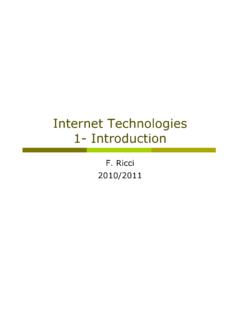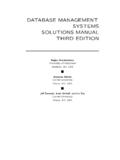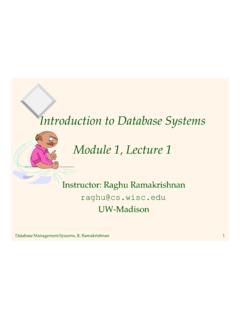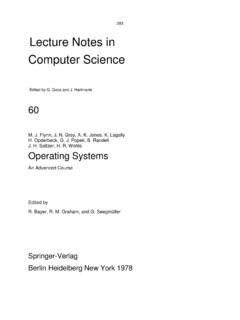Transcription of Introduction to Database Systems - unibz
1 1 Introduction to Database SystemsMotivationWerner Nutt2 Databases Are Everywhere Database = a large (?) collection of related data Classically, a DB modelsa real-world organisation ( , enterprise, university) Entities( , students, courses) Relationships( , Martin is taking IDS in 2010/11 ) Changes in the organisation = changes in the Database Examples: personnel records banking airline reservations3 Scientific Databases (Examples) Biology: , DNA sequencesof genes, amino-acid sequences of proteins, genesexpressed in tissues (up to several Gigabytes) Astronomy: , locationand spectraof astronomic objects (up to several Terabytes) Physics.
2 , sensor measurementsin particle physics experiments (up to several Petabytes)4DB Tendencies Sensorsrecord data DBs grow in size DBs become more widespread date may be less reliable, , uncertain Multimediadata Requirements for larger storage New query operations ( , find a song by humming the melody,find pictures with a given face) Data on the Web Accessed/changed by many people (Facebook,..) Speed up access, loosen consistency (NoSQL)5 Operations with Databases Design Definestructure and types of data Construction Createdata structures of DB, populateDB with data Manipulation of Data Insert, delete, update Query: Which department pays the highest salary?
3 Create reports: List monthly salaries of employees, organisedby department, with average salary and totalsum of salaries for each dept 6An Ideal DB Implementation Should Support: Structure data types data behaviour Persistence store data on secondary storage Retrieval a declarative query language a procedural Database programming language Performance retrieve and store data quickly Data Integrity Sharing concurrency Reliability and resilience Large data volumes7 Database Management system (DBMS) A DBMS is a software package designed to storeand managedatabases A DBMS provides generic functionality(see previous slide)
4 That otherwise would have to be implemented over and over again Reduced application development time Several brands, , Oracle Xi/Yg (Oracle), DB2 (IBM), SQL Server, Access (Microsoft), MySQL, PostgreSQL, HSQLDB, SQLite(open source)8 Database ActorsTool DevelopersOperators and MaintenancePersonnelEnd Users sophisticated casual parametric or canned transactionsDatabaseDesignersDatabaseAdm inistrator(DBA)ApplicationProgrammersDBM S developers on the scenes behind the scenes DatabaseDatabase Management System9 File system : A Physical InterfaceStudent AdminSchedulerPayrollTimetableYear ListsMoneyTransferStudentDataLecturer DataCourseData10 Sharing Data: Replication RedundancyStudent DataCourse DataLecturer DataStudent AdminPayrollTeaching ScheduleLab TimetableTutorialsScheduler11 Sharing Data and OperationsCourse DataLecturer DataStudent AdminSchedulerPayrollScheduleLab TimetableTutorialsStudent DataTeaching 12 DBMS: A Logical InterfaceUniversityDatabase MetadatastudentcourselecturerLab TimetableTeachingScheduleTutorialsDataba se ManagementSystemUniversity DatabaseDataData Dictionary or system Catalog?
5 QUERIES13 File system Approach Uncontrolled redundancy Inconsistent data Inflexibility Limited data sharing Poor enforcement of standards Low programmer productivity Excessive program maintenance Excessive data maintenance14 DBMS Approach Controlled redundancy consistency of data & integrity constraints Integration of data self-contained represents semantics of application Data and operation sharing multiple interfaces Services & controls security & privacy controls backup & recovery enforcement of standards Flexibility data independence data accessibility reduced program maintenance Ease of application an application is simple stringent real-time single user static,files are the option of choiceDBMS downside: more expensive more complex general In a file system , data is physically accessedand not integrated In a DBMS, data is logically accessedand integrated: query language data dictionarySummary.














